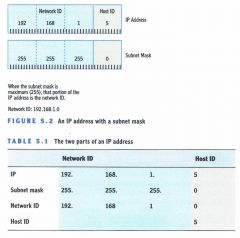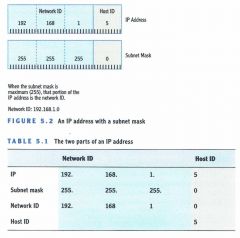![]()
![]()
![]()
Use LEFT and RIGHT arrow keys to navigate between flashcards;
Use UP and DOWN arrow keys to flip the card;
H to show hint;
A reads text to speech;
35 Cards in this Set
- Front
- Back
|
Which of the following IP classes would be the best option when installing 284 computers on a single IP network?
a - Class A b - Class B c - Class C |
b - class B
|
|
|
Your network has a default subnet mask of 255.0.0.0. Which class does this represent?
a - Class A b - Class B c - Class C |
a - Class A
|
|
|
Which of the following IP numbers meet all of the criteria for a private class A network?
a - 100.10.1.0 b - 192.168.1.0 c - 172.16.0.0 d - 10.0.0.0 |
d - 10.0.0.0 (Pg 74)
a - a public network IP address c - a class B private network ID |
|
|
IPv4 resides on which layer of the OSI model?
|
Network layer (layer 3)
|
|
|
IP Class A (public) address range (1st octet) and default subnet mask
State the start of the private class A IP range. |
0-127
255.0.0.0 10.0.0.0 |
|
|
IP Class B (public) address range (1st octet) and default subnet mask
State the start of the private class B IP range. |
128-191
255.255.0.0 172.16.0.0 |
|
|
IP Class C (public) address range (1st octet) and default subnet mask
State the start of the private class C IP range. |
192-223
255.255.255.0 192.168.0.0 |
|
|
Which of the following is a class A loopback address?
a - 192.168.1.0 b - 127.0.1.1 c - 127.0.0.1 d - 192.168.0.1 |
c - 127.0.0.1 Pg 70
|
|
|
Convert 192 to binary
|
1100 0000
|
|
|
Convert 254 to binary
|
1111 1110
|
|
|
Convert 0011 1111 from binary to decimal
|
63
|
|
|
APIPA
|
automatic private IP addressing (pg 74)
Assigns an IP address from the class B 169.254.0.0 network if a windows client can't obtain an IP address from a DHCP server and is not configured statically. |
|
|
Default gateway
|
the IP address of the first device a client computer looks for when seeking a connection outside the network. Usually the IP address of a router
|
|
|
What is NAT?
|
Network Address Translation
Hides private internal IP addresses behind a router. Modifies IP addresses as they pass through a network interface device (pg 151) or router. |
|
|
What is a subnet?
What is a mask? |
A subnet is a division of your logical IP network
A mask is any binary number that is a 1. If a binary digit is 0, then it is unmasked. |
|
|
What reasons do network administrators implement subnetting?
|
To organize/compartmentalize networks
To reduce broadcast traffic To increase network security To increase data throughput To limit access To use IP addresses more wisely Pg 79, 82 |
|
|
What is CIDR?
|
Classless inter-domain routing
Mixing different classes of IP addresses and subnet masks to create a great deal more addressing combinations. (pg 85) Designed to slow the exhausting of IPv4 addresses Example - 192.168.0.0 /16 - this indicates the subnet mask has 16 masked bits (or 1s) which makes it 255.255.0.0 - the default class B subnet mask. The class C IP address combined with a class B subnet mask makes the combination classless. |
|
|
Which of the following IP addresses are valid?
a - 10.80.1.15 b - 172.16.5.254 c - 10.80.256.5 d - 192.168.1.4 e - 172.16.254 |
a - 10.80.1.15 - yes
b - 172.16.5.254 - yes c - 10.80.256.5 - no, no number can be > 255 d - 192.168.1.4 - yes e - 172.16.254 - no, missing the last number |
|
|
What are the two parts to an IP address?
(hint - every address has two parts, called IDs) What does the subnet mask do? (hint - it is part the IP address dividing process) |

A network ID, which identifies the subnetwork (or subnet) where the computer is located
A host ID, which identifies the computer within that subnet The subnet mask identifies the portion of the IP address that is the network ID. Where the subnet mask is 255, the corresponding part of the IP address is the network ID. |
|
|
Consider the following IP address and subnet mask. What part of the IP address is the network ID?
192.168.1.5 255.255.255.0 |

The network ID is 192.168.1.0
For each 255 in the subnet mask you include the corresponding portion of the IP address in the network ID. Where there are zeroes in the subnet mask, you place a zero in the IP address. |
|
|
ARP
|
Address resolution protocol
A layer 3 IP protocol that resolves (translates) IP addresses to MAC addresses, allowing connectivity between the layer 3 IP and layer 2 ethernet systems. The IP protocol uses ARP to determine if computers are local or remote. If the destination IP address has a different network ID it is considered to be on a remote subnet. In that case, the process is repeated until either a local address if found or, if not, data will be sent through the default gateway. To look at two IP addresses and determine whether they are both on the same local subnet do the following: Determine the network IDs of both addresses. If they are the same, they are local. (info from two text books and wikipedia) |
|

Look at the following 3 address combinations and determine if the source and destination addresses are local to each other.
|
1. The network ID for both is 192.168.1.0; therefore they are local to each other.
2. The network ID for both is 10.80.0.0; therefore they are local to each other. 3. The network ID for the source is 192.168.1.0 and for the destination it is 192.168.11.0. Therefore the destination is remote. |
|
|
What does it mean that IPv4 is a "classful" logical addressing scheme?
|
It means that the range of possible addresses (from 1-223) are divided into classes from A-C. More specifically, they range from 1.0.0.0 - 223.255.255.254.
|
|
|
Determine the network ID, class, and subnet mask from the following IP address:
192.168.1.3 |
Class: C
Subnet Mask - 255.255.255.0 Network ID - 192.168.1.0 |
|
|
Determine the network ID, class, and subnet mask from the following IP address:
172.16.4.7 |
Class - B
Subnet mask - 255.255.0.0 Network ID - 172.16.0.0 |
|
|
Determine the network ID, class, and subnet mask from the following IP address:
10.80.20.4 |
Class - A
Subnet mask - 255.0.0.0 Network ID - 10.0.0.0 |
|
|
T/F:
The following is a link-local unicast address: fe80::260:8ff:fec0:98d%4 |
True (Pg 88)
the :fe80" defines it as a link-local IPv6 address Link-local addresses consist of Windows auto-configured addresses, starting with either FE80, FE90, FEA0, or FEB0, and the loopback address, AKA ::1 |
|
|
What are the 3 parts of an IPv6 address such as 2001:4800:0000:2001:0000:0000:0000:0068 ?
|
Global routing prefix Subnet Interface ID
2001:4800:0000 2001 0000:0000:0000:0068 Defines the network | host IP subnet of the network the address is located on |
|
|
What is the proper way to abbreviate an IPv6 address such as
2001:4800:0000:2001:0000:0000:0000:0068 ? |
Replace all the 0s after 2001 with ::68 to get
2001:4800:0000:2001::68 Remember, the :: can only be used once, so trying to use it for the 4 zeroes after 4800 would be incorrect. |
|
|
How would you ping the local loopback address in IPv6?
|
ping::1 (pg 89)
|
|
|
What is a dual IP stack?
|
A situation where there are two IP software implementations in an OS - one for IPv4 and one for IPv6.
Having both present allows programmers to write networking code that supports both protocols. In such an environment, IPv4 addresses are written a bit differently with ::ffff: inserted at the beginning (pg 93) |
|
|
What is IPv6 tunneling (AKA IP 6 to 4)?
|
A service that encapsulates IPv6 packets inside IPv4 datagrams. This allows connectivity for IPv4 hosts that are behind an IPv4 device or IPv6 unaware device, thus preserving backward-compatibility with IPv4.
Such an address would look like such: Fe80::5efe:10.0.0.2%2 Pg 93 |
|
|
You have installed a device that has two IP addresses. One address, 64.51.216.27, is displayed to the internet. The other, 192.168.50.254, communicates with the LAN. What technology have you implemented?
a - subnetting b - IPv6 c - NAT d - Class A public address |
c - NAT, or Network Address Translation
|
|
|
Which of the following is a valid private address?
a - 169.254.255.22 b - 192.169.1.1 c - 192.168.44.105 d - 127.200.191.1 |
c - 192.168.44.105
a - 169.254.255.22 is an APIPA address. APIPA uses network ID 169.254.0.0 (all addresses that begin with 169.254...) b - 192.169.1.1 falls outside of the private address range d - addresses beginning with 127 are reserved for local loopback use. Class A private addresses are only 10.... Class B private addresses range from 172.16... to 172.31... Class C private addresses range from 192.168.0... to 192.168.255... Anything outside of these ranges are most likely public IP addresses. |
|
|
Which of the following IP addresses is a site local address? What does that mean?
a - FF01::1 b - FE80:1234:03D4:4F83:5ABC:1283:0321:ABCD c - FECO:1234:03D4:4F83:5ABC:1283:0321:ABCD d - FF02::1 |
c is the correct answer. A site local address must begin with FECO and is relevant on any link within a site.
b - a link-local unicast address, which must begin with FE80. A packet addressed to a link-local address cannot be routed to a different link of the network. An IPv6 router never forwards link-local traffic beyond the local link. a - an interface-local (or "node-local") multicast address d - a link-local multicast address Multicast addresses are used to send a message to multiple nodes and must begin with FF. |

